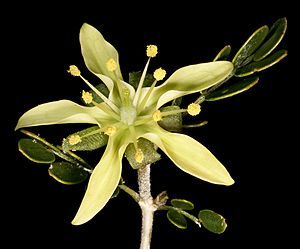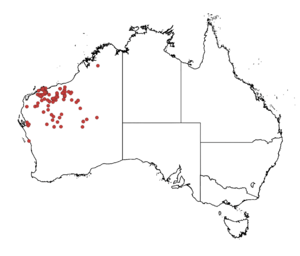Cork hopbush facts for kids
Quick facts for kids Cork hopbush |
|
|---|---|
 |
|
| Scientific classification | |
| Genus: |
Tribulus
|
| Species: |
platypterus
|
 |
|
| Occurrence data from AVH | |
| Synonyms | |
|
Kallstroemia platyptera (Benth.) Engl. |
|
Tribulus platypterus, also known as the cork hopbush, is a type of flowering plant. It belongs to the Zygophyllaceae family. This plant grows only in the northwest part of Western Australia. It is a close relative of another plant called Tribulus suberosus.
Contents
About the Cork Hopbush
How it Got its Name
The plant was first officially described in 1863. A scientist named George Bentham gave it its name. He studied a plant sample collected by Francis Thomas Gregory. This sample was found in the Hammersley Ranges.
The name platypterus comes from two Greek words. Platy- means "broad," and -pterus means "winged." This name describes the plant's fruit, which has wide, wing-like parts.
What it Looks Like
The cork hopbush is a spreading shrub. It usually grows to be about 40 to 100 centimeters (1.3 to 3.3 feet) tall. It can spread out from 50 to 200 centimeters (1.6 to 6.6 feet) wide.
Its stems usually do not have corky bark. The leaves grow in pairs that are not equal in size. Each leaf has 4 to 7 pairs of smaller leaflets. These leaflets are about 4 to 23 millimeters long.
The flowers grow on upright stalks. The petals are about 10 to 11 millimeters long. They are not hairy. The plant has 10 stamens, which are the parts that produce pollen.
The fruit is round and has five wings. These wings are what give the plant its "broad-winged" name. The fruit is about 12 to 18 millimeters long.
The cork hopbush mostly flowers from August to October.
Where it Lives
The cork hopbush is found in several areas of Western Australia. These areas include the Central Kimberley, Gascoyne, Little Sandy Desert, Murchison, and Pilbara regions.
It often grows in rocky places. You can find it near creek banks and in sandy creek beds.
Conservation Status
Under the laws in Western Australia, this plant is considered "not threatened." This means it is not currently at risk of disappearing.

